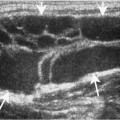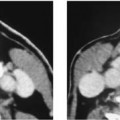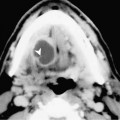Chapter 165 The arrangement of the cervical fascia can readily explain how tumors tend to spread in a predictable manner. The retropharyngeal, parapharyngeal, and prevertebral spaces are well-recognized routes for the spread of infection and malignancy. Malignant infiltration can take place along the parapharyngeal space or the carotid space (Fig. 165–1). Patients usually present with symptoms related to the primary neoplasm. The primary lesion is usually a mucosal malignancy located in the nasopharynx, oropharynx, or hypopharynx. Involvement of the CS may produce cranial nerve palsies such as hoarseness and vocal cord paralysis. Late signs include denervation atrophy of the latissimus dorsi and the sternocleidomastoid muscles.
Tumor Spread to the Carotid Sheath
Epidemiology
Clinical Findings
Pathology
Stay updated, free articles. Join our Telegram channel

Full access? Get Clinical Tree








